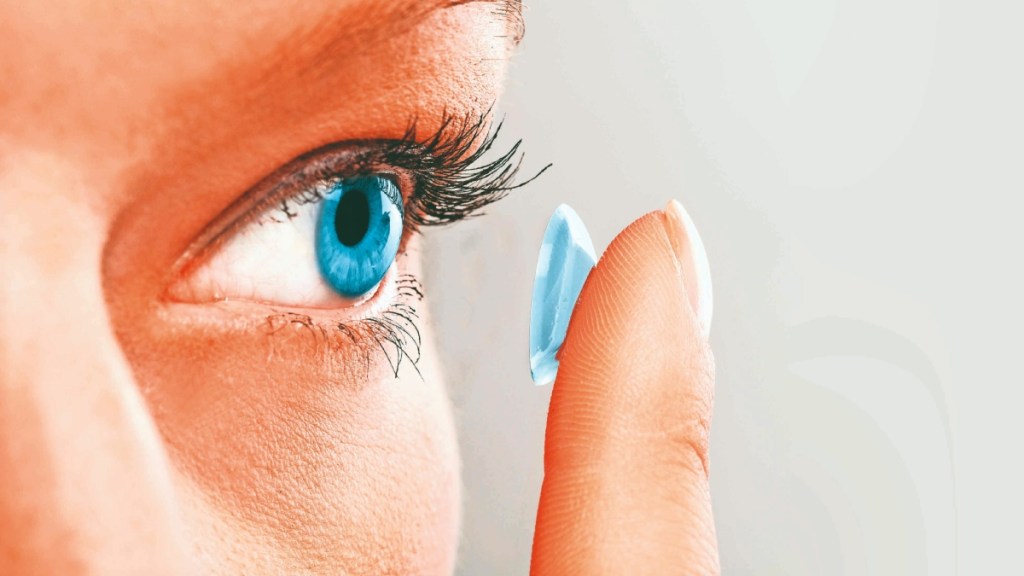A team of scientists in Singapore has developed an ultra-thin battery that can be embedded into your contact lenses, making them ‘smart contacts’. If that’s not enough, the battery can even be charged by your tears. The idea behind the Mission Impossible-style contact lenses, as per Associate Professor Lee Seok Woo of the Nanyang Technological University’s School of Electrical and Electronic Engineering, was to address the power supply issue. Companies around the world have attempted to create smart contact lenses, but have always fallen short of making a safe battery.
Concerned over the safety of the lithium-ion battery, which has the potential to explode or catch fire, Woo considered the tear solution as the electrolyte because it contains sodium chloride, so salt. “We replaced the flammable, organic electrolytes with this tear solution,” he was quoted as saying by the media. “Then we developed the electrode material, working with these salt ions, and then implanted this electrode inside of the contact lens, which means we can save the volume of the battery,” he added.
Lately, there have been a lot of reports on smart contact lenses, most of which are, however, in the prototype or development stage, and can be used for various applications. But what exactly are they and do they actually have any practical benefits? According to Dr Shruti Lanjewar Wasnik, consultant ophthalmologist at Kokilaben Dhirubhai Ambani Hospital, Mumbai, smart contact lenses are cutting-edge tools that do more than just improve vision. “They offer various features like monitoring of glucose levels or intraocular pressure. They can also deliver medications such as antihistamines and glaucoma medications directly to the eyes. Smart contact lenses can project virtual displays allowing users to access information and control devices with their eyes. They can also magnify images and assist people with low vision,” she adds.
The developments in the world of vision correction are seeing radical progress. There are plenty of potential new applications for development and approval of innovative new contact lenses. “Today, we see developments across materials being used, the benefits they offer and impairment areas being addressed rather than just correcting refractive errors. It was a question of time before contact lenses would be used as disease detectors and drug delivery devices, like other wearable devices are. The varying range of breathable materials used, which are healthier for the eyes, is fascinating, as is the design that makes the lens more comfortable and adaptable,” says Tanaz Buhariwalla, Asia director, IDA Ireland, the Irish government’s foreign investment agency. Ireland is one of the top manufacturers of contact lenses worldwide.
Smart contact lenses are so far not available in India but researchers across the world are working on developing them with advanced features such as telescopic lenses that can zoom in and out with a blink of an eye and ‘smartphone control’ that lets people use their contact lenses to operate their smartphones, says Dr Wasnik of Kokilaben Dhirubhai Ambani Hospital.
Smart contact lenses hold significant promise, says Dr Parul Sharma, principal director and HOD, ophthalmology, Fortis Hospital, Gurgaon. “They offer potential applications in healthcare, augmented reality (AR) and personal data monitoring. In healthcare, smart contact lenses are being used for glucose monitoring, drug delivery, low vision aid, etc. Currently, they are still largely in the research and development phase,” she adds.
A new viewpoint
Nevertheless, we can see numerous innovations and advancements in contact lens technology. For instance, there are some companies that are now making what we call drug-eluting contact lenses. Basically, the drops that are needed for the health of the eyes are embedded within the contact lenses and are released at regular intervals of time. “The advantage of this is that you can make sure the drug is actually reaching the place it needs to. For patients like those with glaucoma who need lifelong treatment, sometimes compliance is a problem. They don’t manage to put the drops at the correct time. But this way you are ensuring that there is an uninterrupted supply of the drug through the contact lenses,” explains Dr Anita Sethi, principal director & HOD, ophthalmology, Max Hospital, Panchsheel Park, New Delhi.
“The disadvantage, of course, is that you have a contact lens on the cornea all day long, and if proper care is not taken, there is always a chance of infection when you have the lens on,” she adds.
Contact lens technology has advanced significantly, says Dr Rishi Bhardwaj, senior consultant, ophthalmology, Paras Health, Gurugram. “Innovations include daily disposable lenses that reduce infection risk, silicone hydrogel materials that allow more oxygen to reach the cornea, and multifocal lenses for presbyopia. Toric lenses for astigmatism and photochromic lenses that adjust to light conditions also enhance user comfort and vision quality,” he adds.
A glass apart
Now that we have come to know so much of what is happening in the world of contact lenses, let us see if they are better than the traditional eyeglasses. According to Dr Prarthna Anand, senior consultant, ophthalmology, Yatharth Hospitals, the choice between contact lenses and eyeglasses depends on various factors including lifestyle, ocular health and personal preferences. “Contact lenses offer advantages such as a wider field of vision, no visual obstruction, suitability for sports and active lifestyles, and cosmetic benefits. However, they require hygiene, carry a higher risk of eye infections, and involve ongoing replacement costs,” she explains.
Eyeglasses, on the other hand, are low maintenance, protect eyes from environmental debris, and can serve as a fashion accessory. “When choosing between the two, patients should consider their daily activities, budget, eye health conditions, and comfort preferences,” adds Dr Anand.
Between contact lenses and glasses, the latter is better because they don’t actually sit on the eye, says Dr Sethi of Max Hospital. “Glasses don’t cause any allergic effects or dry eye effects because of over wear or long periods of wear as contact lenses do. But there are some professions where the glasses are a problem, like some sports or people who have to be on screen because there are reflections. So, those patients will definitely need contact lenses,” she explains, adding: “There’s no good or bad. It really depends on your needs.”
Both options have their advantages and potential disadvantages, says Dr Wasnik of Kokilaben Dhirubhai Ambani Hospital. “A consultation with an eye doctor can help you find the best option that is tailored to your individual needs and ensures optimal vision and eye health,” she adds.
For your eyes only
- Coloured: These contact lenses have become increasingly popular for cosmetic purposes
- UV-blocking: These are made with a special coating that prevents harmful UV rays from entering the eyes
- Disposable: Designed to be worn for a day before being discarded, they are hygienic, reduce the risk of eye infections
- Toric: These are designed to correct astigmatism, in which the cornea is irregularly shaped
- Multifocal: These are designed to correct presbyopia, which affects near vision as people age
- Telescopic: These help people with age-related macular degeneration see better
- Long-wear: Made with materials that allow more oxygen to pass through to the cornea, they can be worn up to 2-3 weeks
- Hybrid: A combination of rigid gas permeable, soft contact lenses, these are best for people with irregular corneas
- Orthokeratology: Temporarily change the cornea to correct myopia. Worn overnight, removed in the morning
- Smart lenses: Monitor health indicators like glucose, eye pressure, include AR technology for real-time information
— Dr Shruti Lanjewar Wasnik, consultant ophthalmologist, Kokilaben Dhirubhai Ambani Hospital, MumbaiContact lens care
- Hygiene: Always wash and dry your hands before handling contact lenses
- Solution: Use the contact lens solution recommended by your eye care professional. Never use water or saliva to clean lenses
- Storage: Store lenses in a clean lens case and replace the case every three months. Ensure the case is filled with fresh solution each time
- Avoid sleeping in lenses: Unless prescribed by your eye doctor, avoid sleeping with contact lenses on
- Wearing schedule: Follow the recommended wearing schedule and do not exceed the prescribed duration for wearing lenses
- Handling: Handle lenses with clean, dry hands and avoid touching them with fingernails to prevent tearing
- Makeup: Put on contact lenses before applying makeup and remove them before taking makeup off
- Swimming: Avoid wearing contact lenses while swimming to prevent infection. Never wear contact lenses with any redness or discharge in eye
— Dr Parul Sharma, principal director and HOD, ophthalmology, Fortis Hospital, Gurugram








